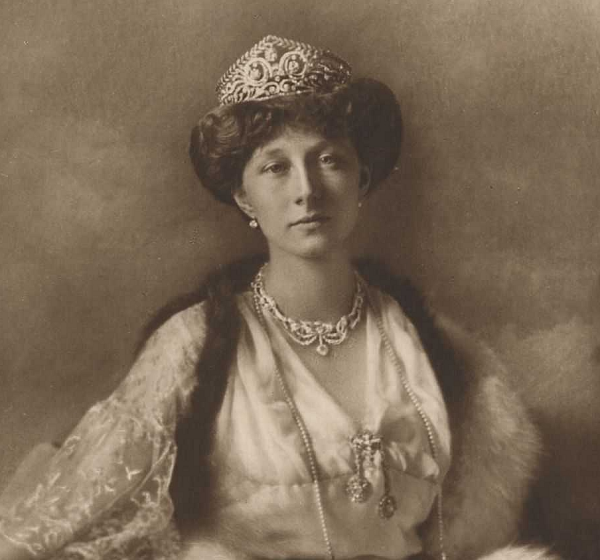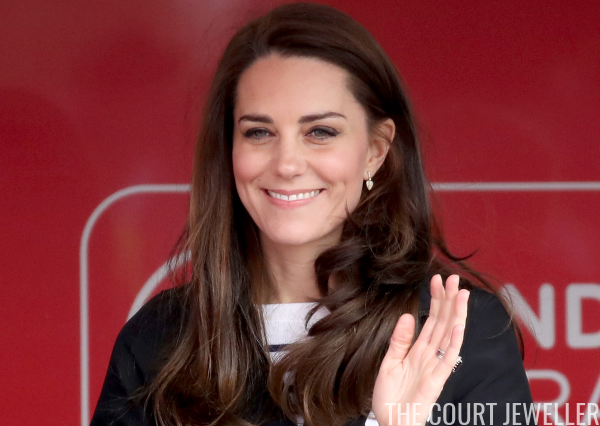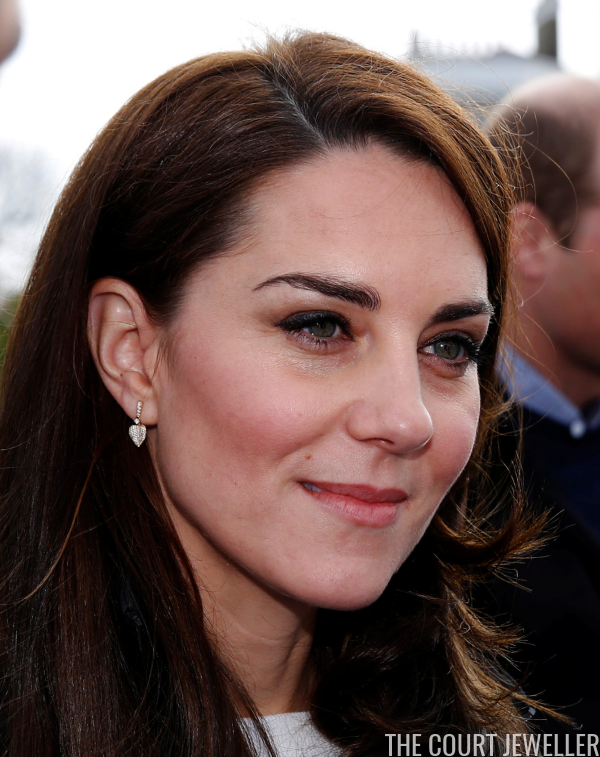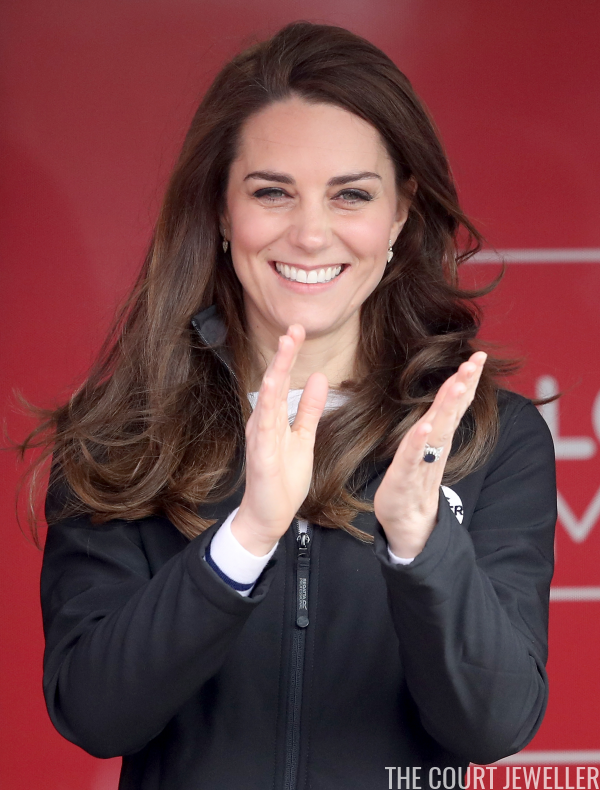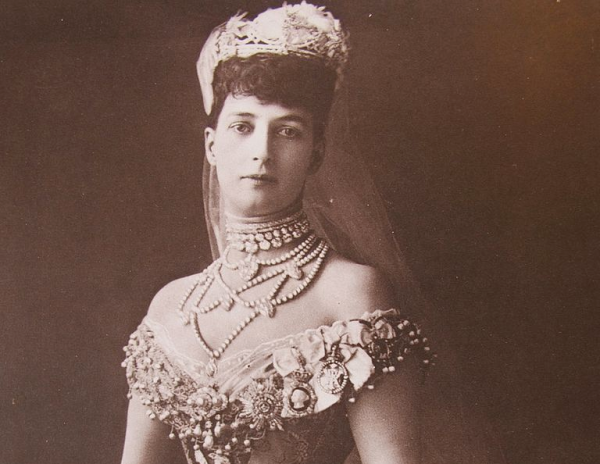 |
| The Princess of Wales, later Queen Alexandra, ca. 1887 (Wikimedia Commons) |
Going to court costs money. A married woman’s costume and accessories often come to $500 or very much more, and a girl’s generally costs $250 [1]. A court train is of great length; it must rest on the ground to the extent of three yards and a half, and is often six yards long from end to end by three yards wide. It used invariably to be made of the richest velvet, brocade, or satin; but last year a fashion was started in favor of gauze trains. Plumes worn on the head are compulsory; three white feathers for a married woman and two for a girl. In deep mourning black feathers are used. White tulle veils or lace lappets must be worn with the white feathers, and black with the black plumes. The bodice must be low, with short sleeves. Formerly this rule was rigidly enforced, but of late years many women have the bodice cut square and some venture upon elbow sleeves. In cases of serious ill-health, the Queen [2] allows a high gown to be worn, but a special permit has to be obtained beforehand from the Lord Chamberlain.
A diamond tiara should be worn, and, of course, necklace, earrings, brooches, etc., while many people wear unique ornaments, such as a diamond girdle, jeweled shoulder-straps, or a multitude of stars fastened on their gowns and train. Long white gloves are obligatory, or black gloves for deep mourning. Tan, light gray, etc., are inadmissible. A girl’s presentation gown is invariably white, as is that of a young married woman; indeed, in these days of eternal youth, many mothers and grandmothers don pure white for their court costumes.
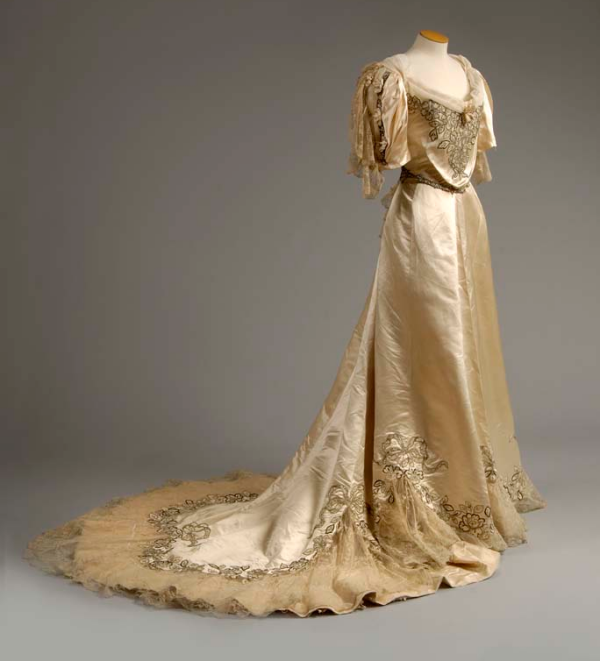 |
| A court dress made by Worth, ca. 1890s (Wikimedia Commons) |
The mode of procedure as regards presentations is simple. A lady wishing to be presented must apply at the Lord Chamberlain’s office at St. James’s Palace for the necessary cards, which should be duly filled with the required information, namely, the lady’s name and address, and that of her father or husband, as the case may be. The lady making the presentation must sign the cards to the effect that she proposes doing so. These cards, the debutante must carefully take with her to the palace on the important day. Once a lady has been presented, it is unnecessary for her to notify beforehand to the Lord Chamberlain her intention of attending a drawing room.
A drawing room usually begins at 3 o’clock, but many hours before the appointed time, all approaches to Buckingham Palace are crowded with carriages, and filled by an eager, excited mass of spectators, waiting to see the rank, fashion, and beauty of London on their way to the Queen’s Drawing Room. The scene in the Mall is brilliant and amusing and shows a London crowd in its pleasantest aspect. Smart carriages, splendid horses, pretty women, dressed and jeweled to perfection, and — lining the route — an admiring, good-natured, outspoken populace. “Pretty dear, don’t she look a beauty?” “Ain’t she a one-er?” and similar remarks are heard on all sides. Pale, pinched faces and red, swarthy ones are pressed close to carriage windows, and many funny incidents occur. It is on record that a well-known countess, not young, but of brilliant coloring, put her head out of the window to give an order to the coachman, when she was unceremoniously kissed on the cheek by a greatly daring “rough!” And this scene goes on for hours.
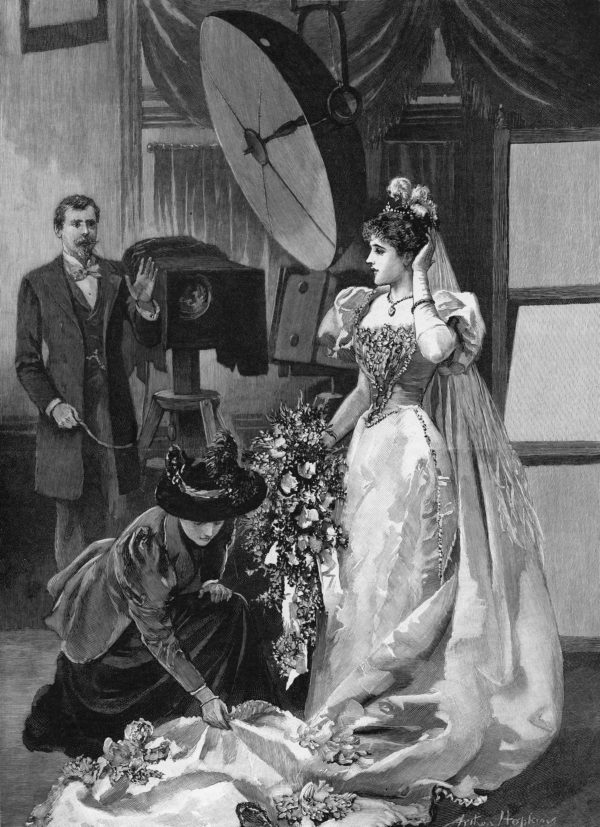 |
| “After the Drawing Room: A Visit to the Photographer” by Arthur Hopkins; originally published in the Graphic in May 1895. Note that the debutante wears the obligatory short sleeved evening dress with a long train and ostrich feather headdress (Hulton Archive/Getty Images) |
Some ladies, such as our country cousins, or the mothers of expectant debutante daughters, love to be early on the scene, and actually take their place “in the rank” as early as 11 in the morning. A funny feature of the affair is that luncheon must, of necessity, be eaten en route. Exhausted nature is refreshed by biscuits, sandwiches, and a pull from a flask, by fair ones dressed in velvet, with diamond tiaras and hothouse bouquets.
There are two entrances to the palace — the great central gateway used by people in general, and another, situated outside Buckingham Gate, which is reserved for those who have the privilege of entree. The entree is strictly limited, and is the right of only a select few. These are the entire diplomatic circle, cabinet ministers and their wives, and the members of the Queen’s household. Besides these privileged persons, Her Majesty can and does bestow it on a favored few. All such are received by the Queen before the general circle and in strict order of precedence. With the general company no such rule of precedence is observed: the Duchess of Distinction, from Belgrave Square, and Mrs. Smith, from the suburbs, are on an equal footing in this respect. They enter the presence chamber in accordance with the actual order of their arrival and with no respect to persons. It is as well to mention that the lady making the presentation must be present at the drawing room, but she need neither accompany the debutante nor pass the royal presence at the same moment.
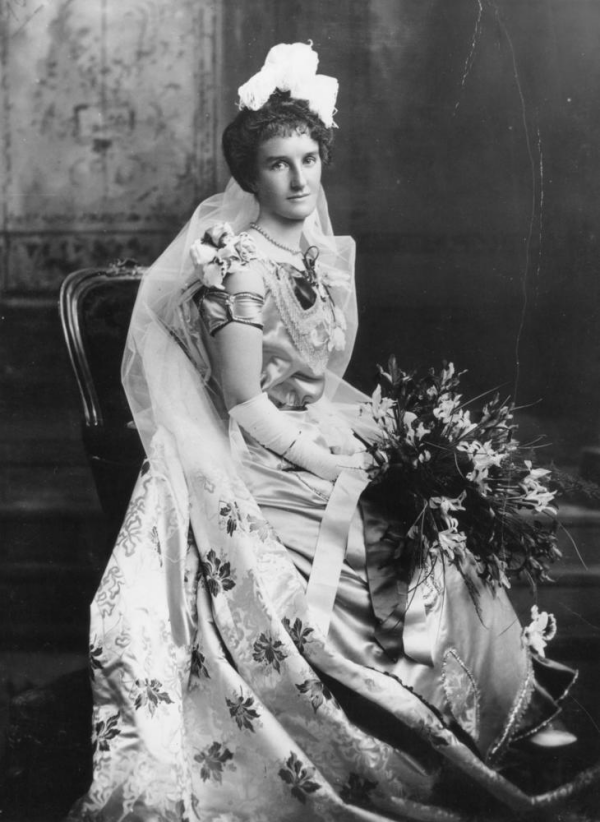 |
| Agnes Melanie Dickson, photographed after her presentation at court, ca. 1890s (Wikimedia Commons) |
Arrived at the palace, the lady to be presented, leaves her cloak in the cloak room, a vast apartment, where women servants — the palace housemaids, in fact — are in attendance. She then makes her way up the grand staircase, carrying her train carefully folded on her arm, for naturally such an appendage cannot be allowed to trail. She passes along the corridor, handing one card to a page-in-waiting, and then enters the first salon. All the rooms and passages of the Queen’s palace are lofty, imposing, and furnished and decorated in a style of heavy magnificence. The gilding is profuse, and the walls, chairs, and sofas are all upholstered in rich red brocade. Valuable paintings hang on the walls. The carpets are thick and soft, and of the same deep red. The gentlemen-at-arms, in their splendid uniforms, stand at the doors of each room and close the gilt barriers when they consider the saloon sufficiently full.
A lady on being presented to Her Majesty, kisses her hand, courtesying very low. She should lift the Queen’s hand, which is extended for that purpose, on the palm of her own hand and kiss it gently and very lightly. A common mistake is to begin the courtesy too soon, and too far away from the Queen. The exceptions to this rule are: all peeresses; the daughters of dukes, marquesses, and earls; the wives of the eldest sons of peers of the above degrees; and the wives of the youngest sons of dukes and marquesses. All these ladies the Queen kisses on the cheek as the lowly bow before her. Foreign ladies are not expected to kiss the Queen’s hand. When the Princess of Wales or any other royal princess holds a drawing room, a lady who is not being presented courtesies only, and does not kiss hands. A court courtesy is not the slow, sweeping obeisance taught by dancing masters, but should be deep and quick; in fact, the common “charity bob.”
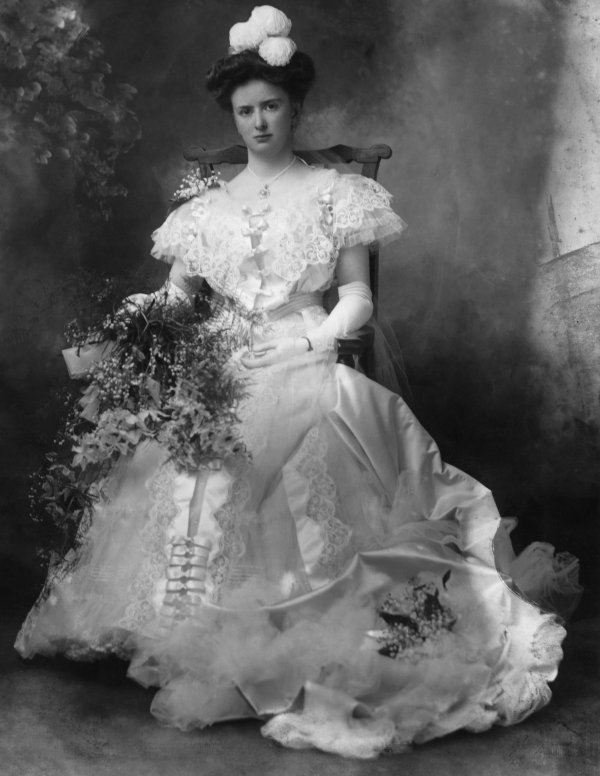 |
| Mrs. Fox Powys, photographed before her presentation at court, 1904 (Hulton Archive/Getty Images) |
The reverence to the Queen over, a lady passes on, making a succession of these rapid courtesies, including as many royalties as possible, and then disappears from the throne, taking care on no account to turn her back on the royalties. When the last courtesy is completed, an official again folds the train, and places it on the lady’s arm. A lady who merely attends a drawing room does not, of course, kiss hands. The throne room is not a large apartment, and the chair of state, styled the throne, is on one side of it, in a central position. On this, the Queen is seated, for she is now unable to stand, and beyond her stand all the other royalties in strict order of precedence, the Princess of Wales being next to the Queen. If a princess holds a drawing room, she is not seated, but stands in front of the throne. Behind the throne, in a sort of semi-circle, stand high officials of the household: the Mistress of the Robes, who always wears black; the Master of the Horse; the Lord Steward; the Lady-in-Waiting, etc. A courtly crowd fills the other part of the throne room, facing the royal party. Here are the ambassadors and ministers, and their wives and daughters, some distinguished foreigners, officials of the court, gentlemen ushers, et hoc genus omne.
To a woman well-placed in society, the ordeal is lessened by the fact that the royalties know her personally, and the Prince and Princess of Wales and the other princes and princesses shake hands with her, and say a few gracious words in passing. The Queen herself sometimes shakes hands with a favored subject who has had the honor of a private presentation. Attendance at a drawing room is the privilege of the upper classes, nobility, gentry, and those engaged in great commercial enterprises. But the line is rigidly drawn at “retail” trade, no matter how wealthy, or well-born, or well-married the applicant may be.
NOTES
1. Comparing the value of money from previous eras with the value of money today is extremely difficult and inexact, but the costs described here ($250-500) would be, conservatively, around $7,280-$14,600.
2. In 1900, the monarch was Queen Victoria; this was the last year of her reign.
